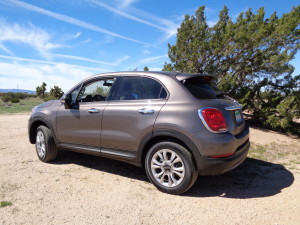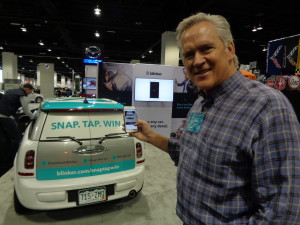
After 14 million sales in 30 years, why change the name of your minivan?
In order to ask that of Chrysler, Jan and I drove 1,300 miles, in a Fiat, to the luxurious Pelican Hill Resort at Newport Beach, Calif., recently.
There was more to it than that; I was invited there to attend the unveiling of the 2017 Chrysler Pacifica minivan, successor to the Town & Country.
Matt McAlear, senior manager of Chrysler Brand Product Marketing for Fiat Chrysler Automobiles, and Rick Deneau, head of Chrysler and Alfa Romeo Brands, and other Chrysler executives were on hand to oversee the first drives of the all-new Pacifica.
The minivan market isn’t going away, Deneau said, even though crossovers continue to grow in popularity. “We are seeking a fresh approach with a new name with the Pacifica to maintain our market share domination,” he said. “This one offers unparalleled levels of functionality, technology and styling.” Chrysler expects minivan sales to remain at about 500,000 yearly (minivan sales peaked at 1.37 million in 2000). Longtime rivals to the Town & Country and Dodge Grand Caravan have been the Honda Odyssey and Toyota Sienna. Chrysler and Dodge combined have led the market since launching it with 1984 models.
While the 2016 Grand Caravan will continue to be built through this year, it eventually will go away and
Pacifica will fill Chrysler’s minivan needs.
Designers have softened the front end of the Pacifica over the Town & Country, as well as extend the overall length and width by an inch and the height by 2 inches. Its track has been widened to 68.3 inches, compared with 65.6 on the Town & Country.
An improvement is the new rotary dial shifter on the console, replacing the shifter on the dash. The dial controls the 9-speed automatic transmission tied to the 3.6-liter Pentastar V-6 engine producing 287 horsepower and 262 lb.-ft. of torque for the front-wheel-drive van. It will be the most horsepower among all minivans and is rated at 28 miles per gallon on the highway.
The push of a button by kids will automatically trigger the sliding side doors of the Pacifica, and the van offers a vacuum in a rear corner which, with its hose, can reach all areas of the interior.
And there will be a plug-in hybrid version with an all-electric range of 30 miles; the hybrid will use two electric motors with the 3.6-liter V-6 engine.
Jan and I drove the new Pacifica to San Diego for a tour of the city zoo’s Safari Park.
We drove through heavy rain on our return to Newport Beach; the Pacifica, with its wider track and longer wheelbase was well-planted and predictable in its handling on the rain-filled Pacific Coast Highway.

After complaining about delivery to me of two front-wheel-drive Fiat 500X models several months ago, I received the AWD version for the long drive to California.
After 21 hours of driving time, having covered 1,319 miles to Newport Beach, my summary is: Jan and I agreed the newly bolstered seats were supportive and comfortable, wider than those on other smaller vehicles; biggest complaint was the 500X’s failure to maintain steady highway speeds on the many, many hills through the Southwest with its 2.4-liter 4-cylinder engine and 9-speed automatic transmission; average of 27 miles per gallon for the trip was decent. Boosting the performance capability was the opportunity to move from Eco drive mode to Sport, which raised the revs and delayed shifts in the 9-speed.
The Fiat’s sticker price of $27,005 included an option package of rear park assist, rearview camera, blind-spot and cross-path detection, heated front seats and steering wheel, dual-zone air control and windshield-wiper de-icer.
The subcompact 500X crossover SUV is a sister car to the Jeep Renegade. They both come off a Fiat Chrysler Automobiles assembly line in Melfi, Italy.
We flew back from Newport Beach; had a couple days rest before the opening of the Denver Auto Show.
The Pacifica was among featured new products at the 2016 Denver Auto Show, which ended a five-day run on Sunday at the Colorado Convention Center.
While covering the car show on Wednesday, I met with Rod Buscher, longtime auto dealer and executive, who was there to promote a new venture “to change and improve the used car marketplace for consumers.”

My first contact with Buscher was more than 20 years ago when he was partner in dealerships with John Elway in Denver. He and Elway teamed up in 1987 to purchase a Jeep business and 10 years later they sold their growing group of auto stores to AutoNation. Buscher in 2007 partnered with the George Gillett family to establish a national group of dealerships, Summit Automotive Partners.
The newest venture is Blinker, founded by Buscher (president) and Tony Wilbert (CEO) of San Francisco. “It’s an automotive technology company that provides all the tools and products necessary to make buying or selling a car or truck privately easier, safer and faster,” said Buscher
The explanation makes not a lot of sense until Buscher holds up and aims a mobile app at the rear of a used Mini Cooper Clubman, pushes a button and the app delivers the year, make and model of that car, its mileage and its estimated value. Blinker partners with Black Book to display vehicle valuations.
Blinker has been launched in Colorado this spring with intent to give users the power to buy, sell and research used cars. Buscher and Wilbert plan to launch Blinker in other major markets around the country.
For more information, visit blinker.com or [email protected].